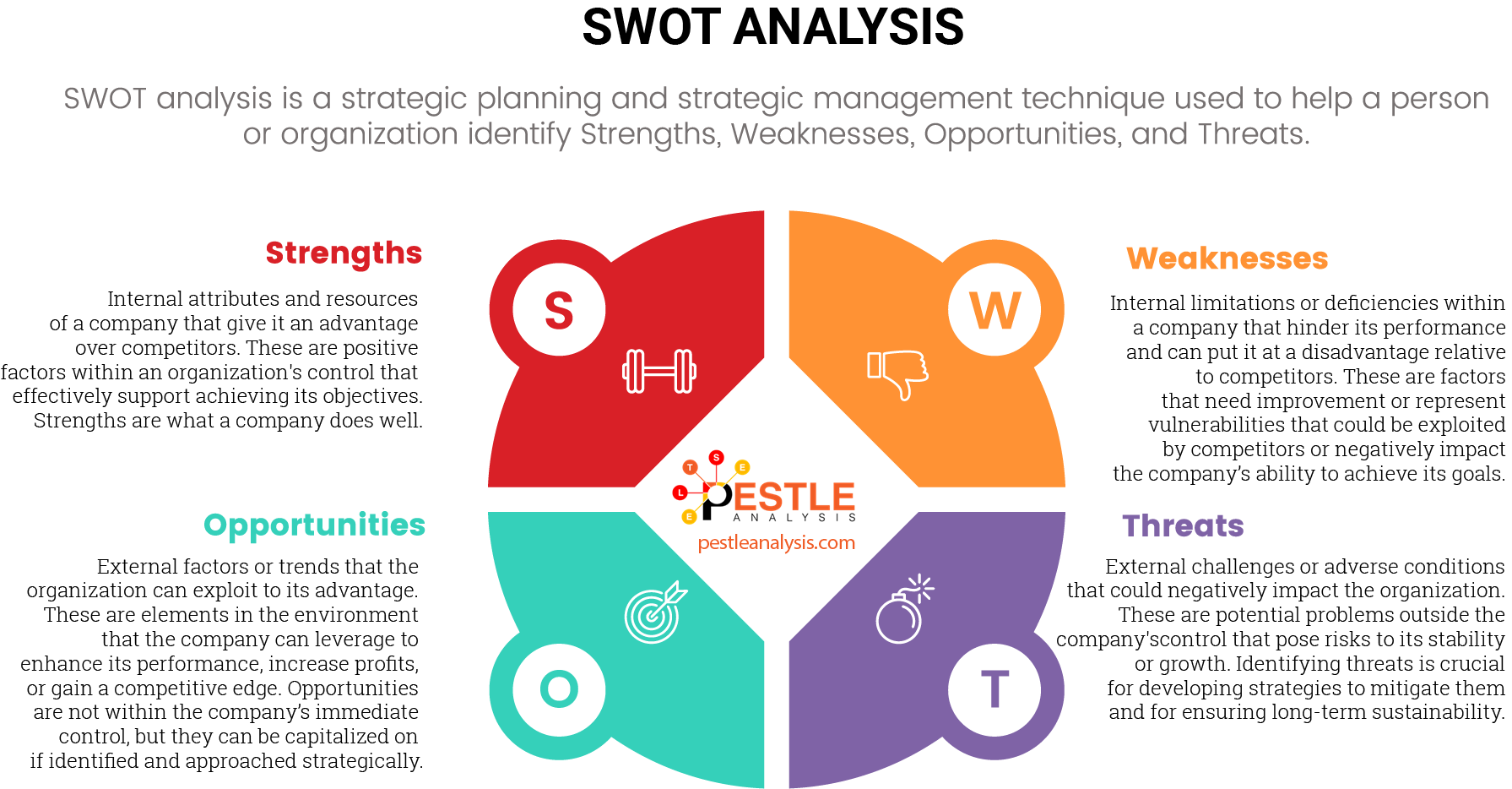You built your business to stick around for decades — not to peak in a few months and then die out in even less time.
Business isn’t simple, especially when the competition is eager to snatch your customers. But with the proper tools for planning, you’ll maintain the upper hand. Whether that means:
- Furthering your competitive advantage
- Building new markets
- Developing new concepts and products, the competition can’t
Getting started is simple: use a SWOT analysis.
It’s an easy premise to help focus on what your company is doing right (and wrong) to keep it strong.
Doing a SWOT analysis may seem easy.
You just need to list down the strengths and weaknesses that your firm has. You also identify the possible opportunities and the threats.
But what are the things that classify as strengths and weaknesses? What scenarios can be called a threat? Which one is an opportunity for the business? To do all these, you need to ask the right SWOT analysis questions.
Starting your SWOT analysis may leave you feeling stuck. You’ll wonder, what’s the most important factor to consider? What is the least? But before that:
What is SWOT analysis?

SWOT analysis stands for Strengths, Weaknesses, Opportunities, and Threats. These four categories force you to understand the current status of your company to ensure it has a future. In SWOT analysis, these categories can be broken down into internal and external factors.
Internal factors
Internal factors are a company's strengths and weaknesses. These may include:
- Brand identity
- Company culture
- Staff
- Geological locations
- Packaging
- Partnerships
Business analysts often conduct SWOT analysis. But for a simple overview, all you need is a pen and paper (or laptop). People who do SWOT analysis tend to focus on the first part: strengths and weaknesses, partly because they’re changeable. But also because it’s easier than analyzing external factors that you don’t have control over.
External factors
External factors in SWOT analysis are opportunities and threats. Often, these factors are out of your control. But by identifying them, you can plan for outcomes.
Opportunities and threats include:
- Economy
- Market size
- Buying behaviors
- Trends
- Weather
- Government regulations
Proper planning is how businesses continue to thrive decades after opening. Identifying company opportunities and threats are critical for planning. So, don’t skip this section because it’s less tangible than strengths and weaknesses.
If an earthquake destroyed your store tomorrow… What’s next? Or if your market size shrinks dramatically in the next 5 years, what will you do?
Obviously, you can’t plan for everything. But by being aware of potential complications, you may increase the survivability of your business.
Now, how do you get started?
SWOT is an acronym for Strengths, Weaknesses, Opportunities, and Threats. So in order to classify factors under these four categories you need to ask several SWOT analysis questions.
Not just any questions.
You have to ask good SWOT analysis questions which are all related to your business.
These questions will differ from business to business.
However, some of the questions are pretty much the same. Let us take a look at some of the common SWOT analysis questions.
Questions to Reveal Strengths in a SWOT Analysis

The strength of a business comes from the internal factors. These are things which you have full control over. Things like resources, skilled labors, investment, machineries and so on. In other words, these are the things that the company does well. So you need to ask certain questions to make sure you get all the strengths listed down. Frequent SWOT analysis questions regarding strength include;
Frequent SWOT analysis questions regarding strengths include;
- What are we known for?
- What is our unique selling proposition?
- What resources do we have readily available?
- What do our customers love about our product(s)?
- What are we doing that no one else is?
- What are your assets?
- Which one of those assets is the strongest?
- What makes you better than your competitors?
- Do you have a strong customer base?
- What is the unique thing about your company?
- How skilled are your labors?
- What are the things that other people say you do well?
- Do you have experience in this task (mission) before?
- What are the advantages you have over your rivals?
Questions to Reveal Weaknesses in a SWOT Analysis
Just like the strengths of a business, the weaknesses are also an internal factor. These things are also under your control. Instead of helping your business, these things will hinder your progress. They prevent you from working at your optimum level. If a competitor knows about your weaknesses, then they are likely to base their strategy based on your weaknesses. The weaknesses are areas you can look to improve upon. These are the SWOT analysis questions that one must ask to find the weaknesses;
These are the SWOT analysis questions that one must ask to find the weaknesses;
- What do our customers dislike about our product(s)?
- What are we doing poorly?
- What is the competition doing much better than we are?
- What resources do we lack?
- What’s the main area we need to improve on immediately?
- What areas do you need improvement on?
- What are the things you need to avoid?
- What areas do your competitors have an advantage on?
- Are you lacking in knowledge?
- Are your employees not skilled enough?
- Do you have enough investment to start such a project?
- Is your customer base too low?
- Are you making enough profit?
- Is your competitor running miles ahead of you?
Questions to Reveal Opportunities in a SWOT Analysis

Opportunities fall into the external factors. These are basically the situations which the company can take advantage of. You cannot control such factors. But you have to take the opportunity when the situation arises.
Opportunities can come in the form of trends, change in taste, economic factors and so on. One has to be very good at spotting such opportunities.
For that, you need to ask the following SWOT analysis questions that deal with opportunities:
- What new opportunities in the market are becoming available?
- How is the market changing?
- What opportunities did we pass, but are still available?
- What would be the ideal opportunity for us?
- What is the competition ignoring that we can play in our favor?
- What external changes will bring your opportunities?
- What are the current ongoing trends?
- Will these trends affect you in a positive manner?
- Can you take advantage of the local market?
- What is the market missing?
- Can you provide that missing link for the consumers?
- Is your rival company failing to satisfy their customer base?
- If so, can you steal their customers?
- Will natural causes like weather and climatic changes give you the competitive edge?
- Is your brand name helping you to get finance easier?
Questions to Reveal Threats in a SWOT Analysis

Threats are also external factors. Just like opportunities, threats are also beyond your control. These factors are going to prevent you from making the most use of your resources. Your marketing strategy will fail due to such reasons. Threats are basically situations that you need to avoid. If you can’t avoid it, you will at least look to minimize its effects. The following SWOT analysis questions are asked to identify the possible threats.
The following SWOT analysis questions are asked to identify the possible threats.
- Who are our competitors?
- Has there been an increase in competition lately? Where and why?
- What are the costs of our resources? Is it affecting our bottom line?
- Are customers buying less of in our industry? Why?
- Are our suppliers unreliable?
- What are the negative aspects in the current market?
- Are there potential competitors who can give you a competition in the future?
- What are the obstacles you are facing in the current mission?
- Have you done anything which may lead to a possible lawsuit?
- Are your key staff members satisfied with their wages and other benefits?
- Do you see them being poached by your rivals?
- Do you see a change in consumer taste?
- Are the government regulations going to affect you?
- What are the chances of a natural disaster affecting your production?
- Will political instability hurt you?
SWOT analysis isn’t all about listing the strengths and the weaknesses. Nor is it about identifying the threats and opportunities. Sure, they are the key things in the analysis, but without the right questions, you can’t progress with the work.
Having the right SWOT analysis questions will ease the workload of the analysis.
By answering these questions, you’ll have a well-rounded approach to conducting your SWOT analysis.
The tougher and more honest questions you can ask, the more reliable the SWOT analysis you will do. Also, make sure you are clear on what mission you are working on. Having a clear idea will make it easier for you to ask those SWOT analysis questions.
But what about SWOT analysis questions about the analysis itself?
Your Top 4 SWOT Analysis Questions Answered

Every business analyst and project manager will ask themselves these questions at some point in their careers when they're called up to conduct a SWOT analysis.
When is the best, most optimal, most perfect time to do a SWOT analysis (to get the most amazing results)?
Unfortunately, I can’t recommend a time that precise. I mean, no one can tell you “do your SWOT analysis once a month between 8am - 9am or suffer the consequences!”
Because it doesn’t work that way.
With that said, there are situations where a SWOT analysis will be more beneficial than at other times. For example, don’t start if you can’t focus on the task. If the kids are constantly asking questions and breaking your train of thought, it’s probably time to put the analysis away for now.
But also consider the situation. If you’re on the fence about changing your career, SWOT analysis can provide insight to help you make a decision.
For example, here's a more personal SWOT analysis situationyour :
SWOT Analysis: Leaving current job for a new career
Strengths:
- Exciting change
- Change of pace/scenery/topics
- It’s something I care about more than with current career
- Booming industry
Weaknesses:
- Pay cut (for at least a few years)
- May require transferring to new cities
- Don’t know anyone/current connections won’t help
Opportunities:
- Make 30% more in a few years than my current job
- Branch into new sectors/industries related to this one
- Can work from home/remotely 2 days a week (be with partner or kids more)
Threats:
- Alienate current connections
- Lose friends/coworkers (if moving, etc)
- Not easy to go back to an old career if this doesn’t work out.
This is just a short example, but you’re able to write down the good, the bad, and the potentially great advantages. And you can do it objectively before taking that leap. You don’t want to be that person who changes careers without accounting for the pay cut. You’ll be stressed and maybe even resent the change.
SWOT analysis helps you think logically and make a decision based on that logic. So, rather than focusing on a specific, literal time to do it, think about the situation. If you’re considering doing something – a change of any sort – would it be smart to do a SWOT analysis first? Most likely, the answer will be “Yes!”
Do I have to be an analytical genius to do SWOT analysis?
Of course not.
The average person can do a SWOT analysis and still uncover useful glimmers of truth.
Take a look at the above SWOT analysis example. It’s incredibly simple and barebones, isn’t it? And yet, it still offers insight into the topic. It allows a person to manage their thoughts in a logical and coherent way.
You don’t need to block out 4 hours of your time to research and write. If you’ve got 30 minutes, you’ve time to do SWOT. That’s what makes it so popular: It’s available for everyone at any time.
Obviously, the more time you can dedicate to the analysis, the better it can be. You’ll be able to think more critically and more thoroughly. It’s easy to pop out the first few thoughts and ideas.
But after a while? You’ll be plagued to write down even one more thought. Yet that’s when the best insights reveal themselves.
I’ve seen business owners use SWOT to figure out their unique selling proposition. Or authors who want to understand the best and worst parts about their book (and then they figure out how to address the issues). Business analysts also use SWOT but the point is, you don’t have to go to school to use it.
What do I do after the SWOT analysis?
This was quickly addressed above, but simply put? You got to use what you learned.
It’s disheartening to realize many people become so focused on doing the analysis that they chuck their results to the side. Although it can be helpful just to know your strengths or threats, it’s always smarter to figure out ways to use the info directly.
Have you ever taken an online course for something? People do it for business.
They’ll take a course about social media or marketing strategies. They’ll go through the teachings/modules fill a binder full of notes. They nod to themselves while they listen, occasionally smiling because everything they’re learning totally makes sense. But then the course ends and they jump right onto the next one.
All those notes?
Might as well just be a paperweight.
What they should do is start practicing what they learned.
In the case of SWOT analysis, that means figuring out when and how to implement information (whenever possible). What’s a smart way to go about it? When should you do it? Can you wait to handle the outlined weaknesses to prevent threats from taking over?
Think about the information. Think about how to use it. And then put it to good use.
Do I have to do the whole thing?
No, you don’t. But I recommend that you do.
Many people just do the first half (strengths and weaknesses). I believe it’s because they’re the simplest. You can quickly figure out what you do right and wrong. And then? You just fix them. They’re the “easiest” parts to fix and you have the most control while doing it.
But with the second half (opportunities and threats), it’s a little less set in stone.
You can create opportunities, sure, but many just appear. Your input isn’t necessary. You don’t even have to take the opportunity.
Threats aren’t that different. They exist, they manifest, but you can’t always do something in the moment. Basically, you’re not powerless during these sections, but you’re not as powerful either.
If you need quick answers and know that unveiling strengths or weaknesses will help (and you can put the information into effect immediately) go for it. But you’ll get the full picture of your situation from doing the entire analysis








